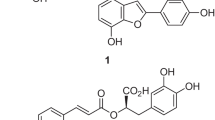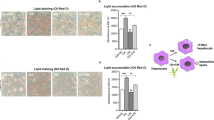Abstract
The peroxisome proliferator-activated receptor (PPAR)α is mainly expressed in the liver and plays an important role in the regulation of lipid metabolism. It has been reported that PPARα activation enhances fatty acid oxidation and reduces fat storage. Therefore, PPARα agonists are used to treat dyslipidemia. In the present study, we found that 9-oxo-10(E),12(Z),15(Z)-octadecatrienoic acid (9-oxo-OTA), which is a α-linolenic acid (ALA) derivative, is present in tomato (Solanum lycopersicum) extract. We showed that 9-oxo-OTA activated PPARα and induced the mRNA expression of PPARα target genes in murine primary hepatocytes. These effects promoted fatty acid uptake and the secretion of β-hydroxybutyrate, which is one of the endogenous ketone bodies. We also demonstrated that these effects of 9-oxo-OTA were not observed in PPARα-knockout (KO) primary hepatocytes. To our knowledge, this is the first study to report that 9-oxo-OTA promotes fatty acid metabolism via PPARα activation and discuss its potential as a valuable food-derived compound for use in the management of dyslipidemia.





Similar content being viewed by others
Abbreviations
- 9-oxo-OTA:
-
9-Oxo-10(E),12(Z),15(Z)-Octadecatrienoic acid
- 9-oxo-ODA:
-
9-Oxo-10,12-Octadecadienoic acid
- BSA:
-
Bovine serum albumin
- DMEM:
-
Dulbecco’s modified eagle’s medium
- EtOH:
-
Ethanol
- HAD:
-
cis-10-Heptadecenoic acid
- LC–MS:
-
Liquid chromatography–mass spectrometry
- LNA:
-
Linoleic acid
- ALA:
-
α-Linolenic acid
- PBS:
-
Phosphate-buffered saline
- PPAR:
-
Peroxisome proliferator-activated receptor
- QTOFMS:
-
Quadrupole-time-of-flight MS
- UPLC:
-
Ultra performance LC
References
Reilly MP, Rader DJ (2003) The metabolic syndrome: more than the sum of its parts? Circulation 108:1546–1551
Miranda PJ, DeFronzo RA, Califf RM, Guyton JR (2005) Metabolic syndrome: definition, pathophysiology, and mechanism. Am Heart J 149:33–45
Kahn BB, Flier JS (2000) Obesity and insulin resistance. J Clin Invest 106:473–481
Ginsberg HN (2000) Insulin resistance and cardiovascular disease. J Clin Invest 106:453–458
Escher P, Wahli W (2000) PPARs: insight into multiple cellular functions. Mutat Res 448:121–138
Desvergne B, Wahli W (1999) PPARs: nuclear control of metabolism. Endocr Rev 20:649–688
Chinetti G, Fruchart JC, Staeles B (2000) PPARs: nuclear receptors at the crossroads between lipid metabolism and inflammation. Inflamm Res 49:497–505
Duval C, Chinetti G, Trottein F, Fruchart JC, Staeles B (2002) The role of PPARs in atherosclerosis. Trends Mol Med 8:422–430
Goldenberg I, Benderly M, Goldbourt U (2008) Update on the use of fibrates: focus on bezafibrate. Vasc Health Risk Manag 4:131–141
Bernal-Mizrachi C, Weng S, Feng C, Finck BN, Knutsen RH, Leone TC, Coleman T, Mecham RP, Kelly DP, Semenkovich CF (2003) Dexamethasone induction of hypertension and diabetes is PPARα-dependent in LDL receptor-null mice. Nat Med 9:1069–1075
Reddy JK, Hashimoto T (2001) Peroxisomal β-oxidation and PPARα: an adaptive metabolic system. Annu Rev Nutr 21:193–230
Tugwood JD, Issemann I, Anderson RG, Bundell KR, McPheat WL, Green S (1992) The mouse PPAR recognizes a response element in the 5′ flanking sequence of the rat acyl CoA oxidase gene. EMBO J 11:433–439
Roepstorff C, Halberg N, Hillig T, Saha AK, Ruderman NB, Wojtaszewski JF, Richter EA, Kiens B (2005) Malonyl-CoA and carnitine in regulation of fat oxidation in human skeletal muscle during exercise. Am J Physiol Endocrinol Metab 288:E133–E142
Miller CW, Ntambi JM (1996) Peroxisome proliferators induce mouse liver stearoyl-CoA desaturase one gene expression. Proc Natl Acad Sci USA 93:9443–9448
Bogna GG (2014) PPARs and their ligands: nutritional and clinical implications. Nutr J 13:17
Kim S, Shin HJ, Kim SY, Kim JH, Lee YS, Kim DH, Lee MO (2004) Genistein enhances expression of genes involved in fatty acid catabolism through activation of PPARα. Mol Cell Endocrinol 220:51–58
Pandey DK, Shekelle R, Selwyn BJ, Tangney C, Stamler J (1995) Dietary vitamin C and beta-carotene and risk of death in middle-aged men. The Western Electric Study. Am J Epidemiol 142:1269–1278
Lazarus SA, Bowen K, Garg ML (2004) Tomato juice and platelet aggregation in type 2 diabetes. JAMA 292:805–806
Giovannucci E (1999) Tomatoes, tomato-based products, lycopene, and cancer: review of the epidemiologic literature. J Natl Cancer Inst 91:317–331
Blum A, Monir M, Wirsansky I, Ben-Arzi S (2005) The beneficial effects of tomatoes. Eur J Intern Med 16:402–404
Kim YI, Hirai S, Takahashi H, Goto T, Ohyane C, Tsugane T, Konishi C, Fujii T, Inai S, Iijima Y, Aoki K, Shibata D, Takahashi N, Kawada T (2011) 9-oxo-10(E),12(E)-Octadecadienoic acid derived from tomato is a potent PPARα agonist to decrease triglyceride accumulation in mouse primary hepatocytes. Mol Nutr Food Res 55:585–593
Kim YI, Hirai S, Goto T, Ohyane C, Takahashi H, Tsugane T, Konishi C, Fujii T, Inai S, Iijima Y, Aoki K, Shibata D, Takahashi N, Kawada T (2012) Potent PPARα activator derived from tomato juice, 13-oxo-9,11-octadecadienoic acid, decreases plasma and hepatic triglyceride in obese diabetic mice. PLoS One 7:e31317
Grechkin A (1998) Recent developments in biochemistry of the plant lipoxygenase pathway. Prog Lipid Res 37:317–352
Takahashi H, Hara H, Goto T, Kamakari K, Nomura W, Mohri S, Takahashi N, Suzuki H, Shibata D, Kawada T (2015) 13-Oxo-9(Z),11(E),15(Z)-octadecatrienoic acid activates PPARγ in Adipocytes. Lipids 50:3–12
Takahashi N, Kawada T, Goto T, Yamamoto T, Taimatsu A, Matsui N, Kimura K, Saito M, Hosokawa M, Miyashita K, Fushiki T (2002) Dual action of isoprenols from herbal medicines on both PPARγ and PPARα in 3T3-L1 adipocytes and HepG2 hepatocytes. FEBS Lett 514:315–322
Goto T, Takahashi N, Kato S, Egawa K, Ebisu S, Moriyama T, Fushiki T, Kawada T (2005) Phytol directly activates PPARα and regulates gene expression involved in lipid metabolism in PPARα-expressing HepG2 hepatocytes. Biochem Biophys Res Commun 337:440–445
Takahashi N, Kang MS, Kuroyanagi K, Goto T, Hirai S, Ohyama K, Lee JY, Yu R, Yano M, Sasaki T, Murakami S, Kawada T (2008) Auraptene, a citrus fruit compound, regulates gene expression as a PPARα agonist in HepG2 hepatocytes. BioFactors 33:25–32
Huynh FK, Green MF, Koves TR, Hirschey MD (2014) Measurement of fatty acid oxidation rates in animal tissues and cell lines. Methods Enzymol 542:391–405
Goto T, Lee JY, Teraminami A, Kim YI, Hirai S, Uemura T, Inoue H, Takahashi N, Kawada T (2011) Activation of PPARα stimulates both differentiation and fatty acid oxidation in adipocytes. J Lipid Res 52:873–884
Takahashi H, Kamakari K, Suzuki H, Mohri S, Goto T, Takahashi N, Matsumura Y, Shibata D, Kawada T (2014) Localization of 9- and 13-oxo-octadecadienoic acids in tomato fruit. Biosci Biotechnol Biochem 78:1761–1764
Nakamura MT, Yudell BE, Loor JJ (2014) Regulation of energy metabolism by long-chain fatty acids. Prog Lipid Res 53:124–144
Gao M, Bu L, Ma Y, Liu D (2013) Concurrent activation of liver X receptor and PPARα exacerbates hepatic steatosis in high fat diet-induced obese mice. PLoS One 8:e65641
Lee SS, Chan WY, Lo CK, Wan DC, Tsang DS, Cheung WT (2004) Requirement of PPARα in maintaining phospholipid and triacylglycerol homeostasis during energy deprivation. J Lipid Res 45:2025–2037
Nakamura MT, Yudell BE, Loor JJ (2014) Regulation of energy metabolism by long-chain fatty acids. Prog Lipid Res 53:124–144
Fu J, Oveisi F, Gaetani S, Lin E, Piomelli D (2005) Oleoylethanolamide, an endogenous PPARα agonist, lowers body weight and hyperlipidemia in obese rats. Neuropharmacology 48:1147–1153
Kalinowska A, Górski J, Harasim E, Harasiuk D, Bonen A, Chabowski A (2009) Differential effects of chronic, in vivo, PPAR’s stimulation on the myocardial subcellular redistribution of FAT/CD36 and FABPpm. FEBS Lett 583:2527–2534
Aguiló F, Camarero N, Relat J, Marrero PF, Haro D (2010) Transcriptional regulation of the human acetoacetyl-CoA synthetase gene by PPARγ. Biochem J 427:255–264
Ito M, Fukui T, Saito T, Tomita K (1986) Acetoacetyl-CoA synthetase specific activity and concentration in rat tissues. Biochim Biophys Acta 876:280–287
Acknowledgments
The authors thank S. Shinoto and M. Sakai for secretarial and technical support, respectively. This work was supported in part by Research and Development Projects for Application in Promoting New Policies Agriculture, Forestry, and Fisheries of Japan, by grants-in-aid for Scientific Research from the Ministry of Education, Culture, Sports, Science, and Technology of Japan (22228001 and 24688015), and by Research Fellowships of the Japan Society for the Promotion of Science for Young Scientists (24521).
Author information
Authors and Affiliations
Corresponding author
About this article
Cite this article
Takahashi, H., Kamakari, K., Goto, T. et al. 9-Oxo-10(E),12(Z),15(Z)-Octadecatrienoic Acid Activates Peroxisome Proliferator-Activated Receptor α in Hepatocytes. Lipids 50, 1083–1091 (2015). https://doi.org/10.1007/s11745-015-4071-3
Received:
Accepted:
Published:
Issue Date:
DOI: https://doi.org/10.1007/s11745-015-4071-3




